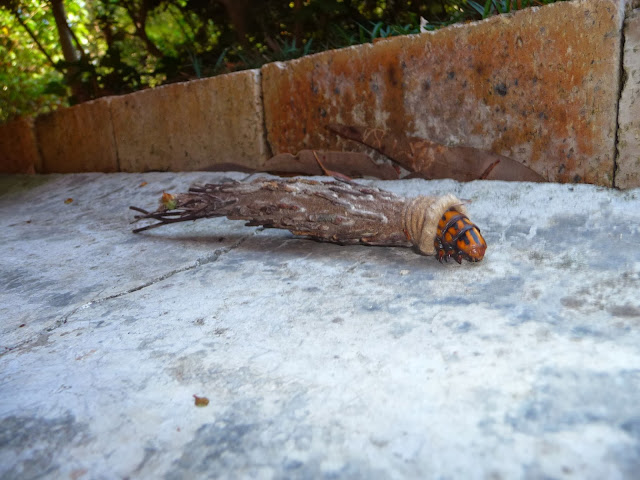We found this interesting fellow the other week - the larva of a Saunder's Case Moth (Metura elongatus). We had some friends visiting at the time and one of them said it might be a cocoon stick insect so we googled the name and found a picture and we were able to identify it easily as it is quite distinctive. It's very large for an insect and I was trying to get my mind around what kind of monstrous moth would develop from it. Apparently it's not so monstrous at all.
First Studies in Insect Life in Australasia by William Gillies told us quite a bit about the Case-Moth: it can remain without food for a long time; it doesn't behave like a normal moth and can take two to three years to go through its life cycle from egg to perfect insect. The mother moth lays her eggs inside the case in spring; in December the caterpillars that develop escape from the case by lowering themselves on a very fine thread to the ground or a plant below the mother's case. An hour or two after this the caterpillars have each woven their first case.
The little case-moth larva carries its home with it wherever it goes, holding it straight up but as it grows it becomes too large to be easily carried. Up to this time the case has been made of silk and bits of leaves but now the caterpillar begins to weave and add to the length of the case using bits of stick - very clever.
Now the case is no longer held up above the body. The caterpillar still moves around but when it gets tired, it fastens its house to a twig by a thread of silk and swings there until it decides to move again.
In about eighteen months after the caterpillar was born the time arrives for the larva to become a pupa. The insect fills up the case with silk and old skin and about six months later the moth emerges (around May to October). Apparently there are few creatures that have more enemies than the case-moth!
There are some good photos of the moth here. And some artwork from a natural history artist here.
St. Andrew's Cross spider
The case-moth is a weaver but the St. Andrew's Cross spider (Argiope keyserlingii) sews - a very nice zigzag at that. Well, that's what I told my daughter. He is actually an orb-weaver spider. This one is probably a male as he's not too large. The female is about three times his size. Fortunately they are non-venemous and not aggressive which is a pleasant change around here as we have some nasties - funnel webs for example, which are both aggressive and highly toxic.
So we don't go barefoot outside and we stomp on our shoes before we put them on.




No comments:
Post a Comment